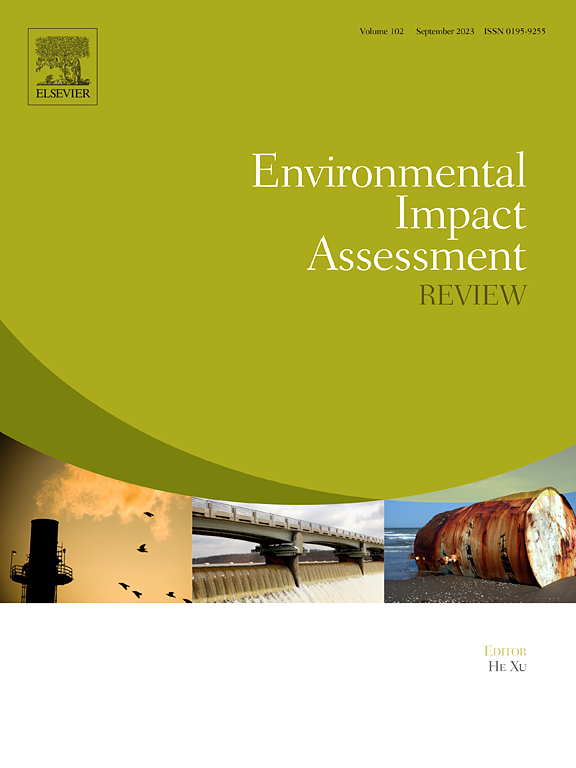从固体废物中再生陶粒的减碳效益是什么?碳足迹的新视角
IF 9.8
1区 社会学
Q1 ENVIRONMENTAL STUDIES
引用次数: 0
摘要
陶粒行业正在经历低碳转型的需求;因此,固体废物正逐渐被用作原料。然而,从固体废物中生产的陶粒产品的碳足迹和未来碳减排效益的程度仍不清楚。因此,本研究评估了污泥、粉煤灰和铝灰这三种难以回收利用的常见危险陶粒废弃物的碳足迹。通过情景分析,对三种固废陶粒产品的减碳潜力进行了预测和评价。同时添加污泥和铝灰生产陶粒是可持续的,提高了陶粒的碳性能。与浙江省的污泥陶粒和山东省的粉煤灰陶粒相比,中国浙江省的污泥铝灰陶粒分别实现了约29%和5%的碳减排效益。三种单因素低碳情景优化了原材料(RMO)、运输(TO)和电力(EO)结构。在TO和EO情景下,单个固体废物陶粒产品的最大减碳量为0.08 kg,低于RMO情景(0.40 kg)。在其他3个协同低碳优化情景中,RM-TO情景(同时优化原材料和运输结构,12 - 68%)的碳减排潜力高于T-EO情景(同时优化运输和电力结构)。同时优化3个因素的减排潜力最高(约70%)。考虑到经济和时间的限制,中国陶粒产品更倾向于运输和原料结构的联合优化。本文章由计算机程序翻译,如有差异,请以英文原文为准。

What are the carbon reduction benefits of regenerating ceramsite from solid waste? A new perspective on carbon footprint
The ceramsite industry is experiencing the demand for low-carbon transformations; therefore, solid waste is gradually being used for raw materials. However, the carbon footprint of ceramsite products produced from solid waste and the extent of future carbon-reduction benefits remain unclear. Therefore, this study evaluated the carbon footprints of sludge, fly ash, and aluminum ash, common hazardous waste ceramsite products that are difficult to recycle. The carbon reduction potential of the three solid-waste ceramsite products were predicted and evaluated based on scenario analysis. The simultaneous addition of sludge and aluminum ash to produce ceramsite was sustainable and improved its carbon performance. Sludge‑aluminum ash ceramsite from Zhejiang Province, China, achieved carbon reduction benefits of approximately 29 % and 5 % compared to the sludge ceramsite in Zhejiang Province and fly ash ceramsite in Shandong Province, respectively. The three single factor low-carbon scenarios optimized the raw material (RMO), transportation (TO), and power (EO) structures. Under the TO and EO scenarios, a single solid-waste ceramsite product achieved maximum carbon reductions of 0.08 kg, which was lower than that of the RMO scenario (0.40 kg). In the other three collaborative low-carbon optimization scenarios, the carbon reduction potential of scenario RM-TO (simultaneously optimizing raw material and transportation structures, 12–68 %) was higher than that of scenario T-EO (simultaneously optimizing transportation and power structures). The emission reduction potential of simultaneously optimizing the three factors was the highest (∼70 %). Considering economic and time constraints, the joint optimization of transportation and raw material structure is preferred for Chinese ceramsite products.
求助全文
通过发布文献求助,成功后即可免费获取论文全文。
去求助
来源期刊

Environmental Impact Assessment Review
ENVIRONMENTAL STUDIES-
CiteScore
12.60
自引率
10.10%
发文量
200
审稿时长
33 days
期刊介绍:
Environmental Impact Assessment Review is an interdisciplinary journal that serves a global audience of practitioners, policymakers, and academics involved in assessing the environmental impact of policies, projects, processes, and products. The journal focuses on innovative theory and practice in environmental impact assessment (EIA). Papers are expected to present innovative ideas, be topical, and coherent. The journal emphasizes concepts, methods, techniques, approaches, and systems related to EIA theory and practice.
 求助内容:
求助内容: 应助结果提醒方式:
应助结果提醒方式:


